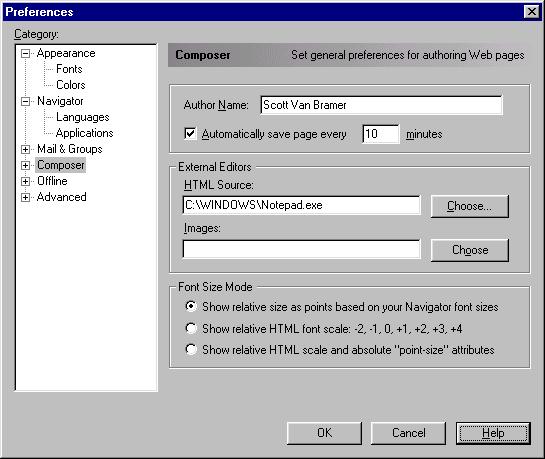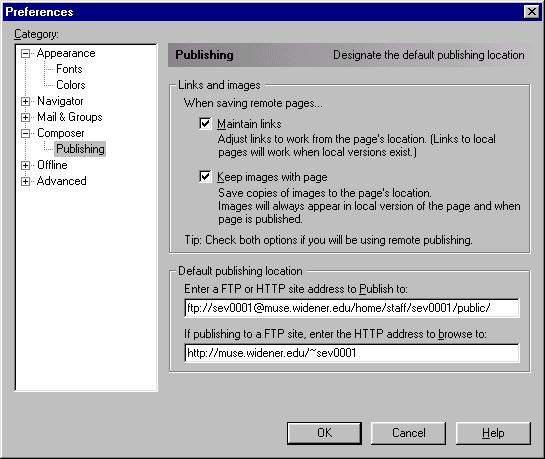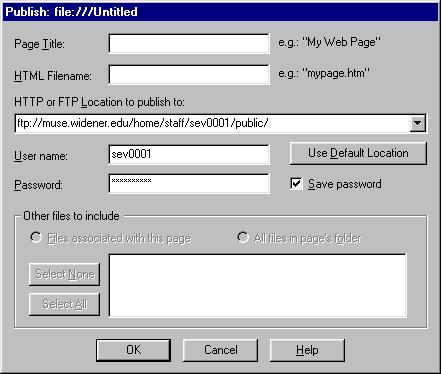Loading Web Pages on Server
After you have created your web pages, you must place them on a web server. This is another step that often causes confusion. When you save a file, it goes on your hard drive or diskette. But since your computer is not a Web server (at least it probably is not), nobody else can see your web pages. For a web page to be accessed through the Internet it must be placed on a server. Most Colleges and Universities have web servers and they will make space available for faculty. For some of the details you will have to check with your local computer group. Below are some of the basics to help you get started and help you know what to ask. After you have an account on a web server, you place your files on the server and then you are on the Web.
At most universities the web server is a UNIX computer run by the central computing service. This may be the same computer that you use for e-mail, or a specific server for web pages. Your local computer group will setup an account for you to use. The exact details for the server and the address will vary from campus to campus, but the general idea will be something like this.
The server will have an address that looks like "science.widener.edu". On that server, you will have a directory that you can log into with your login id and password. That will look like "svanbram". In that directory will be a directory for web pages. It will look like "public_html". The server is then configured so that the web address "science.widener.edu/~svanbram" will go to the "public_html" directory in the "svanbram" directory. The tilde (~) tells the server to make this change. It is critical that the "public_html" directory has the file access permissions set so that you, the owner, can write files to the directory and that anyone can read files in the directory. Unless you know how to use UNIX, your computer group will need to help you with this.
After you have your account. All that you have to do is place your files into the "public_html" directory. The default filename for the "home" page in the directory is "index.html". So that the URL "http://science.widener.edu/~svanbram/" will return the file named "index.html" located in the "public_html" directory, in the "svanbram" directory. If there is no "index.html" file in the directory, the server will return the directory listing. For any other file, the file name must be specified in the URL.
Transfering Files. Copying a file from your computer onto a UNIX server requires using a special program. The protocol for copying files is called FTP (File Transfer Protocol). This is a protocol for transfering files using the Internet. There are several different software programs for doing this. I use a program called WS_FTP that works like the old windows file manager program. If you are using Netscape Composer to write your web pages, there is a built in FTP program that you can use.
WS_FTP is available from Ipswitch. It connects to the web server and opens two file diretories. You then select files and click to transfer them between computers. This works very well if you have a complex web site with an elaborate directory structure. If you create HTML documents using an editor or translator, you will need a program like this.
You can transfer files directly from Netscape Composer to a server using the publish feature. The expectation here is that all your web pages are in a single directory. This can be a problem for complex web sites, but is not an issue for beginners. After everything is configured you write the web page. Click on "save" to save the file on your local computer and then click on "publish" to place a copy of the file on your web server. The details for setting this up are given below, the first time you try it you may want to ask someone for help to get all the settings correct the first time. After that you will just have to click on a button to place your pages on the web server.
Using Netscape Composer.
- In Netscape, click on "Edit", then select "Preferences".
- In the dialog box, select "Composer".
- The box shown below is displayed.

The following options are available.
- Author Name. Enter your name here. This information is included in the heading information for any web page. This is not displayed in the browser, but can be used for other features.
- Automatically Save. This will automatically save the document you are working with on your hard drive. So if your computer crashes you will not loose everything. TURN THIS FEATURE ON.
- External Editors, HTML Source. This lets you edit the raw HTML code. I suggest using notepad for this. On most computers enter "c:\windows\notepad.exe". If that does not work, use the browse button to find the program. If you regularly edit long HTML documents, I would suggest using the program "wordpad".
- External Editors, Images. This automatically links from composer to a program for editing image files. LView is a nice freeware package.
- Font Size Mode. I recommend against using absolute point sizes for web pages. Use relative sizes so that users can specify the base font size, and the web page author just indicates if something should be larger or smaller.
- Help. Read this for more information.
- Click on the + symbol to the left of the word "Composer" in the Preferences window. This opens a branch in the menu. Now click on "Publishing" to display the following options:

- When saving remote pages, Maintain links. This is important for making links work on your local machine while you are editing a document, and on the remote machine when you load it on the web server. It is important that you keep current copies of all files in both locations. This is easily done by always saving and publishing any changes that you make. This is where the distinction between absolute and relative addresses is important. Netscape assumes that you have a directory on your local computer where you save files. This directory contains copies of all your web pages and any other files that you are making links to. There is also a directory on your web server where you "publish" files. This directory is a mirror of the directory on your hard drive and it also contains copies of all your files. When you are editing a web page, Composer uses the local copy. After you finish editing and you are browsing on the web, Netscape uses the file on the web server. To keep everything straight here it is important that you have the same version of a file in both locations.
- When saving remote pages, Keep images with page. This is important for keeping images displayed in a document in the correct place.
- Default publishing location, Enter FTP or HTTP site. This is the address where you are loading your web pages. The exact syntax is important and unless you are familiar with UNIX you will need to ask your computer group for details. Here is an example for publishing a web page on one of the servers at Widener. sev0001 is my login ID, and as a faculty member my files are in the staff directory.
ftp://sev0001@muse.widener.edu/home/staff/sev0001/public/
- Default publishing location, If publishing to a FTP site. This is the address that Netscape uses to look at the document after you publish it. This address is slightly different than the address used for loading the file. In general the tilde and userid (~sev0001) replaces the complete directory structure (/home/staff/sev0001/public). The proper syntax for browsing on this server is:
http://muse.widener.edu/~sev0001
- Help. Click on this button for more information.
- To upload a file from Composer (after all the above is configured), click on the "Publish" button and the following dialog box will appear:

- Page Title. This is the title of the web page. The browser displays it at the top of the window. This may include spaces and may be as long as you like.
- HTML Filename. This is the filename for the web page. I recommend using only letters and numbers, no spaces and no special characters since these can cause unpredictable results depending upon your web server, web browser, and HTML software. Also, UNIX is case sensitive so the filename HOME.HTML is different from the file home.html. The file extension (the part after the period) should be html. The "home" page in any directory (the one you want people to start with) should have the name index.html.
- HTTP or FTP Location to publish to. This should come up with the default address entered above. This box has a pull down menu (click on the down arrow at the right) that will list any other directories or servers that you use. The syntax for this line is:
ftp://sev0001@muse.widener.edu/home/staff/sev0001/public/
- User name. This is your login id.
- Password. This is your password. If you click on the box to the right, Netscape will remember your password.
- Other files to include. If you need to upload additional files to the same directory, select them from this box. These could include a powerpoint presentation or a mass spectrum that you link to in your web page. You need to have all these files on the web server.
This page is maintained by
Scott Van Bramer
Department of Chemistry
Widener University
Chester, PA 19013
Please send any comments, corrections, or suggestions to
svanbram@science.widener.edu.
This page has been accessed
times since 5/30/97.
Last Updated Tuesday, September 10, 2002 10:10:41 AM


